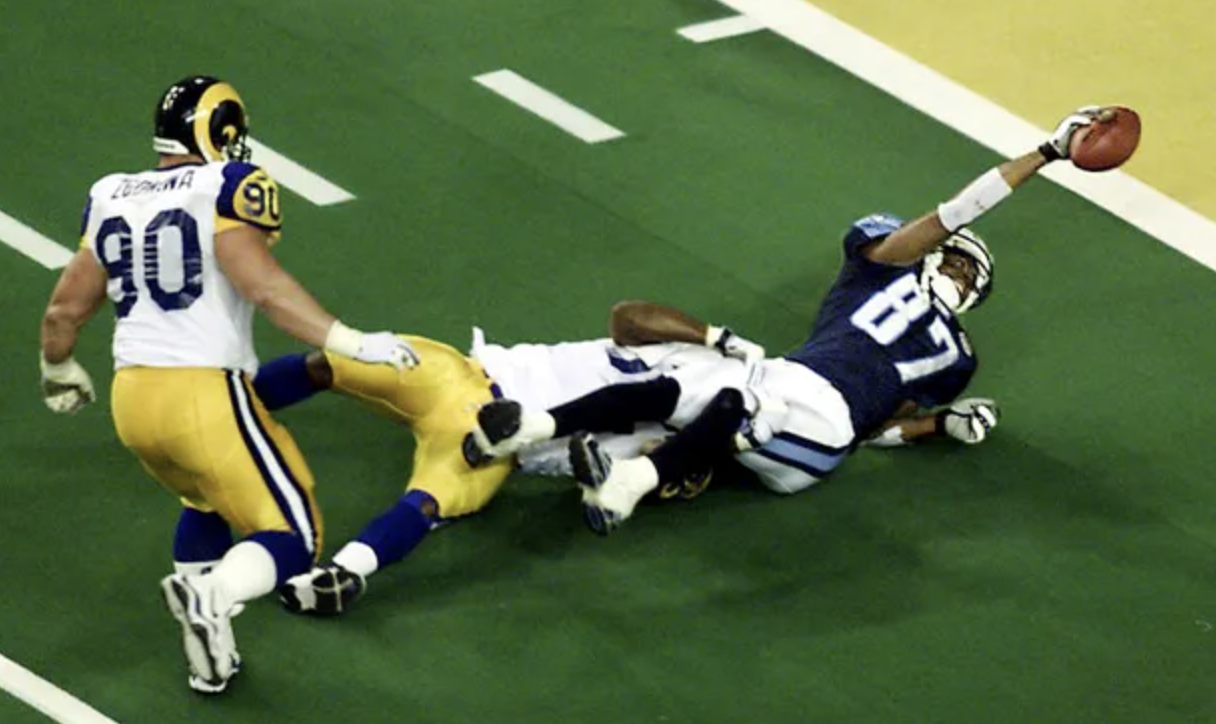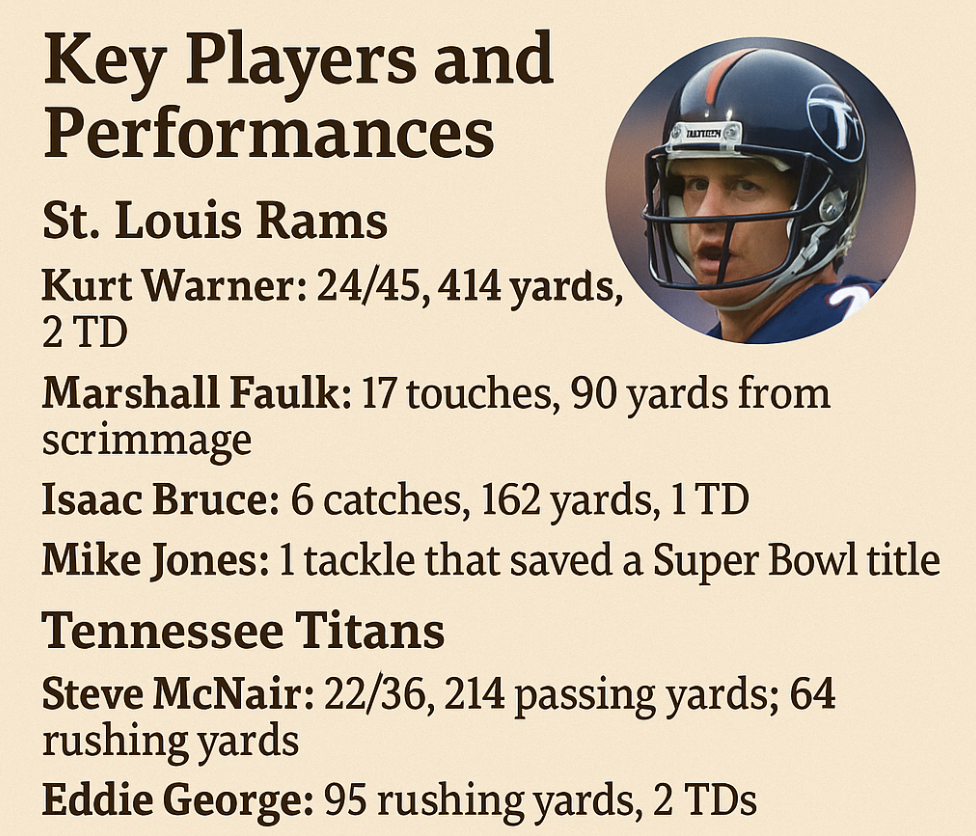Super Bowl XXXIV: The Greatest Yard in Football History

On January 30, 2000, the sports world watched in awe as one of the most thrilling conclusions in Super Bowl history unfolded at the Georgia Dome in Atlanta. Super Bowl XXXIV pitted the explosive St. Louis Rams—nicknamed "The Greatest Show on Turf"—against the resilient Tennessee Titans, a team that embodied grit, toughness, and resolve.
The final play of the game would etch itself into NFL lore as "The Tackle", a moment that defined careers, franchises, and the essence of what makes the Super Bowl the pinnacle of competitive drama.
The Build-Up: Titans Rise, Rams Revive
The 1999 season had its share of surprises, but none bigger than the sudden ascension of both Super Bowl contenders. The St. Louis Rams, led by the unheralded grocery-store-clerk-turned-MVP Kurt Warner, had posted a dominant 13-3 record, scoring more points than any team in football. Their offense, featuring Warner, Marshall Faulk, Isaac Bruce, and Torry Holt, redefined offensive pacing and creativity.
On the other sideline, the Tennessee Titans, in their first year under the new moniker after moving from Houston, emerged from the AFC as a Wild Card team. Behind quarterback Steve McNair, running back Eddie George, and a rugged defense, the Titans rode a wave of momentum fueled by their miraculous "Music City Miracle" victory in the Wild Card round.
“Super Bowl XXXIV was the NFL’s version of poetry and power,” said Dr. Lionel Tate, senior analyst at the Super Bowl Historical Society. “On one side, you had a team that could score in seconds. On the other, a team that would grind you into submission. Clash of philosophies, same goal.”
First Half: Rams Dominate, Titans Stumble
The game began with the Rams asserting their offensive identity. Warner methodically picked apart Tennessee’s defense, converting third downs and setting the tone. However, despite their early dominance, the Rams could not find the end zone in the first half, settling instead for three field goals from Jeff Wilkins.
Meanwhile, the Titans struggled to move the ball. The Rams' front seven, led by Kevin Carter and D'Marco Farr, kept Eddie George in check, and McNair found few open targets against St. Louis’s aggressive secondary.
At halftime, the Rams held a 9-0 lead, and it felt as though the dam was about to break.
Third Quarter: Rams Finally Break Through
The long-awaited touchdown came in the third quarter. Kurt Warner connected with Torry Holt, the rookie sensation, on a 9-yard slant route to extend the Rams' lead to 16-0.
But the Titans wouldn’t go quietly.
McNair, embracing his dual-threat nature, began to find his rhythm, mixing scrambles with precise passes. Eddie George bullied his way into the end zone with two rushing touchdowns in the second half, and Al Del Greco added a field goal to tie the game at 16-16 with just over two minutes remaining.
What looked like a runaway was now a nail-biter.
The Final Two Minutes: A Game of Inches
With just 2:05 left on the clock, Kurt Warner dropped back and delivered a perfect rainbow to Isaac Bruce, who made a subtle cut past the cornerback and sprinted 73 yards to the end zone. The Rams were back on top: 23-16.
Then came Steve McNair’s final stand.
The Titans drove from their own 12-yard line to the Rams’ 10, aided by McNair’s scrambling brilliance—none more iconic than his escape from a near-sack to fire a 16-yard dart to Kevin Dyson.
With six seconds remaining and one play left, the Titans had a chance.
“You could feel the air thicken in that stadium,” recalled Marjorie Kessler, a historian with the Super Bowl Historical Society. “It wasn’t just about who would win. It was about history holding its breath.”
McNair found Dyson on a quick slant inside. He caught it cleanly at the 5-yard line and lunged...
...only to be tackled one yard short by linebacker Mike Jones, who wrapped Dyson just enough to prevent him from reaching the goal line.
Final Score and Scoring Summary
| Quarter | Rams | Titans |
|---|---|---|
| 1st | 3 | 0 |
| 2nd | 6 | 0 |
| 3rd | 7 | 6 |
| 4th | 7 | 10 |
| Total | 23 | 16 |

MVP: Kurt Warner
Kurt Warner finished the game with 414 passing yards, 2 touchdowns, and no interceptions—making him the Super Bowl MVP. His 414 yards remain one of the highest passing totals in Super Bowl history.
Warner’s story became the stuff of legend: from stocking supermarket shelves to lifting the Lombardi Trophy in just over two years.
Key Players and Performances
St. Louis Rams
- Kurt Warner: 24/45, 414 yards, 2 TD
- Marshall Faulk: 17 touches, 90 yards from scrimmage
- Isaac Bruce: 6 catches, 162 yards, 1 TD
- Mike Jones: 1 tackle that saved a Super Bowl title
Tennessee Titans
- Steve McNair: 22/36, 214 passing yards; 64 rushing yards
- Eddie George: 95 rushing yards, 2 TDs
- Kevin Dyson: 6 catches, 66 yards
The Tackle: One of the Greatest Defensive Plays in History
“The Tackle,” as it’s now known, has become synonymous with the drama of the Super Bowl. Unlike last-second heroics that involve miracle catches or missed field goals, this was pure willpower. Mike Jones read the play, timed the hit, and drove through Dyson before he could extend the ball across the plane.
“A lot of plays win games. But that play saved a legacy,” said Dr. Tate. “It’s the kind of tackle you practice every week, and yet almost never make when it counts most.”
Cultural and Broadcast Notes
- Network: ABC
- Announcers: Al Michaels and Boomer Esiason
- National Anthem: Faith Hill
- Halftime Show: Phil Collins, Christina Aguilera, Enrique Iglesias, Toni Braxton (themed around Millennium Celebration)
- Viewership: 88.5 million
This Super Bowl kicked off the 2000s with fireworks and would later be remembered as one of the most-watched and discussed games of the decade.
Legacy: The Rise of the Rams, the Resilience of the Titans
The Rams Dynasty That Never Was
While St. Louis returned to the Super Bowl two years later (and lost to Tom Brady’s Patriots), many believed that this team could have won multiple titles. Warner, Faulk, and Bruce would all go on to Hall of Fame careers, but internal injuries and coaching turnover derailed any sustained dynasty.
The Titans' Heartbreak
Tennessee came within inches—literally—of tying the Super Bowl. Though McNair and George remained consistent stars, the team would never get closer than that final yard.
Fun Facts
- Kurt Warner’s 414 passing yards are still among the top five in Super Bowl history.
- The Rams were the first team to win the Super Bowl after relocating (from Los Angeles to St. Louis).
- Steve McNair's combination of poise, toughness, and improvisation earned widespread praise—even in defeat.
Final Thoughts
Super Bowl XXXIV stands as a monument to what football can be at its best: fast-paced, dramatic, and unforgettable. In the game’s final seconds, two men—Dyson and Jones—collided at the one-yard line, and in that instant, the difference between champion and runner-up was rendered in flesh, force, and fate.
In a game full of fireworks, it was one perfect tackle that made history.
Would you like an infographic summarizing this game next?